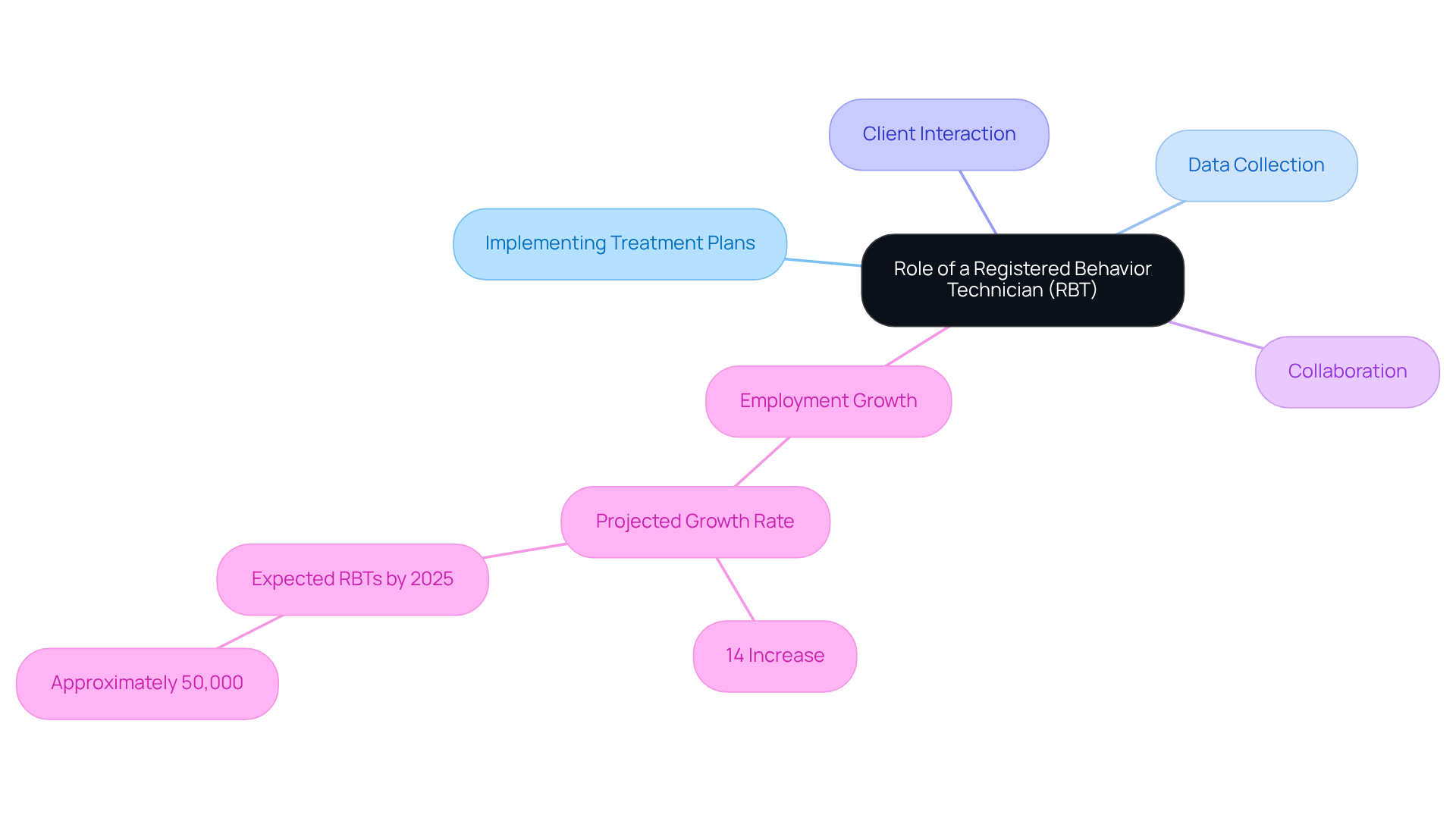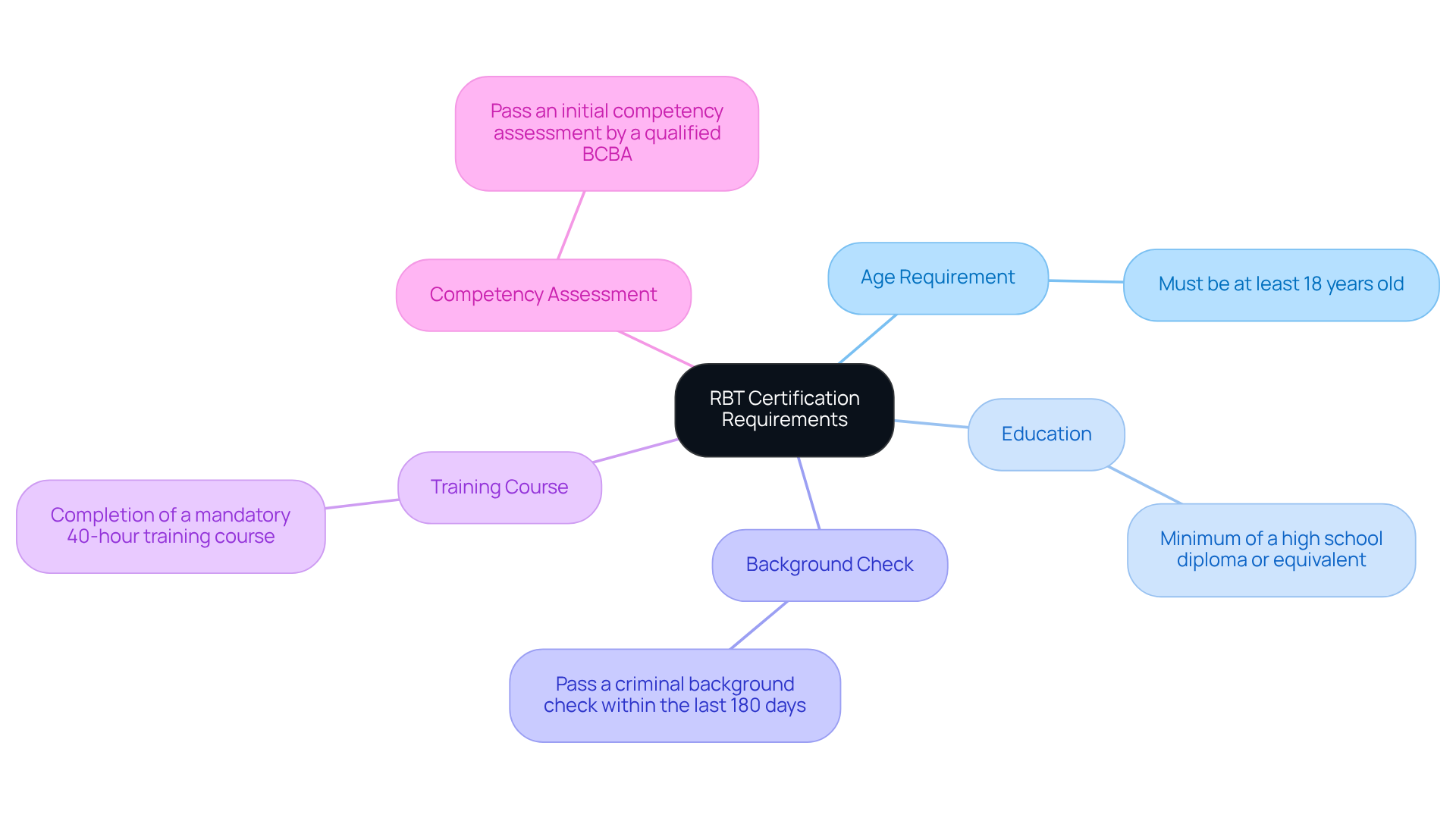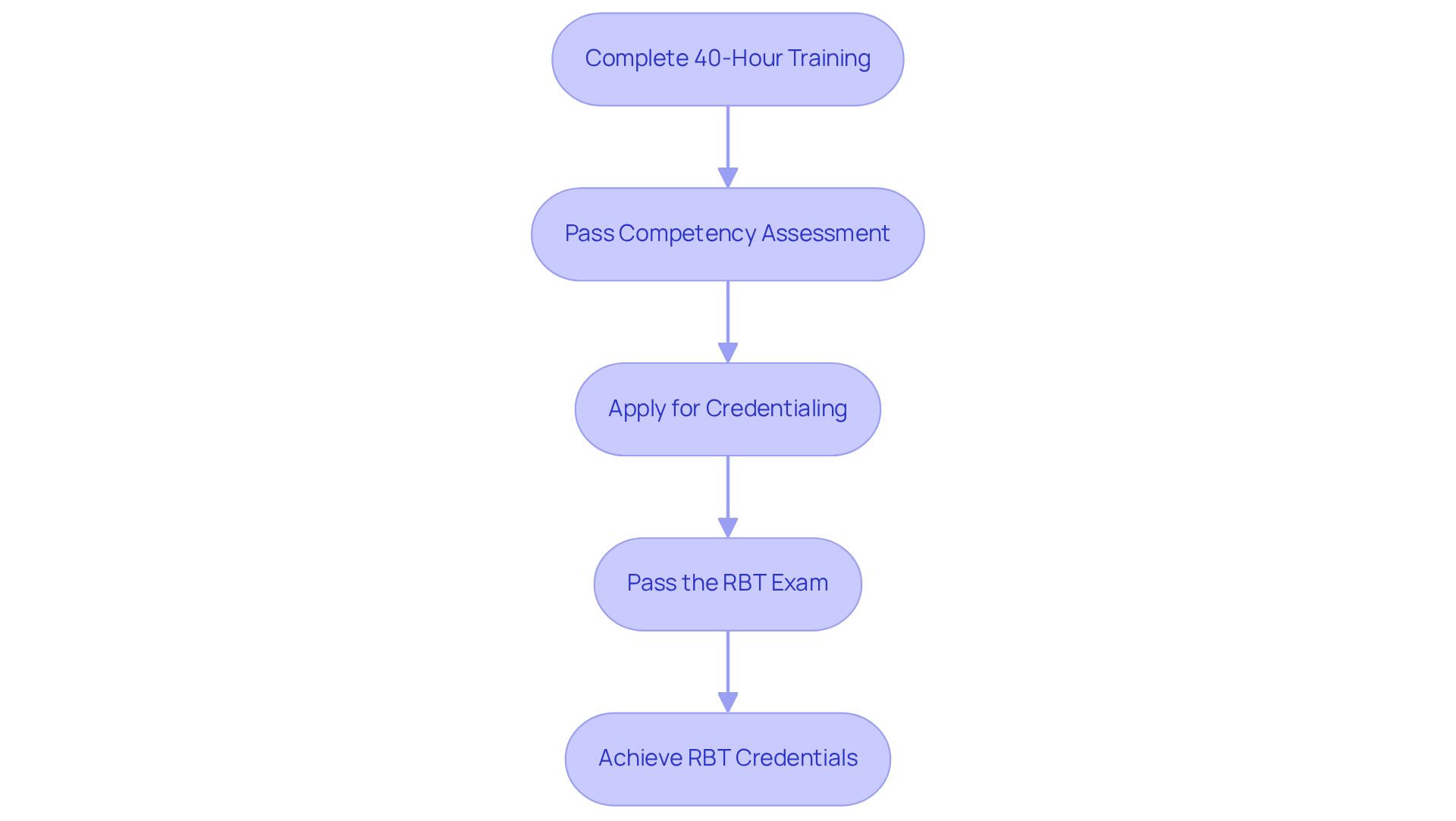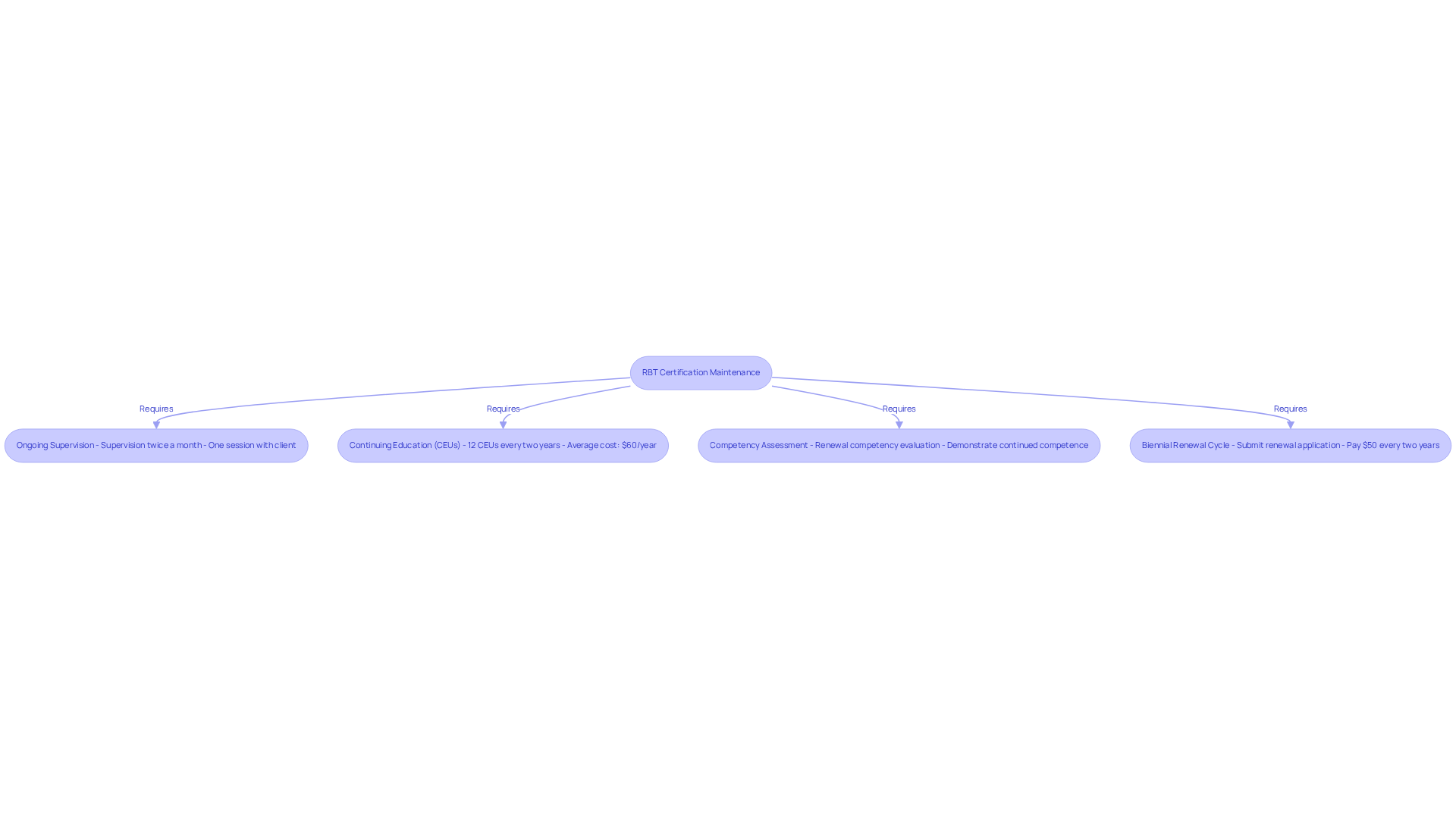July 2, 2025

The essential steps for obtaining and maintaining RBT certification encompass:
It is crucial to recognize the significance of comprehensive training and adherence to ethical standards. This ensures that Registered Behavior Technicians are equipped to effectively support individuals in ABA therapy. Are you prepared to meet these standards and excel in your role?
The role of a Registered Behavior Technician (RBT) has become increasingly vital in the landscape of Applied Behavior Analysis (ABA) therapy, particularly as the demand for such services continues to surge. With expectations of nearly 50,000 RBTs by 2025, understanding the certification and maintenance requirements is essential for aspiring professionals. Yet, what does it truly take to navigate the complexities of RBT certification, from initial training to ongoing professional development? This article delves into the key steps and requirements for becoming a certified RBT, ensuring that candidates are well-equipped to provide high-quality care in a field that significantly impacts the lives of individuals with autism and other developmental disabilities.
A Registered Behavior Technician (RBT) is a paraprofessional who implements behavior-analytic services in accordance with RBT requirements under the supervision of a Board Certified Behavior Analyst (BCBA). As the demand for ABA therapy continues to rise, forecasts suggest a remarkable 14% growth in Registered Behavior Technician employment from 2016 to 2026. By 2025, the number of professionals in this field is expected to approach around 50,000. The essential contributions of RBTs to patient care, particularly for individuals with autism, highlight the importance of RBT requirements. Their key responsibilities include:
The impact of Registered Behavior Technicians on participant outcomes is significant, as demonstrated by case studies illustrating enhanced skill development and reduced challenging behaviors among individuals undergoing ABA therapy. For example, one case study highlighted an individual who, with the support of an RBT, achieved a 40% increase in communication skills over six months. BCBAs emphasize that Registered Behavior Technicians must adhere to RBT requirements to play a crucial role in delivering high-quality care, asserting that their practical assistance is essential for achieving positive outcomes for clients and their families. Ultimately, the RBT requirements ensure that RBTs serve as the frontline support in ABA therapy, significantly enhancing the quality of life for individuals with autism and other developmental disabilities.

To qualify for RBT certification, candidates must meet the RBT requirements that emphasize the significance of this role in the field of Applied Behavior Analysis (ABA) therapy.
These requirements are designed to ensure that registered behavior technicians possess the foundational knowledge and ethical standards necessary for effective practice in ABA therapy.
As the demand for registered behavior technicians continues to grow, the significance of thorough training and compliance with ethical guidelines cannot be overstated. In 2025, statistics indicate that approximately 75% of candidates meet the RBT requirements for certification, underscoring the importance of thorough preparation. Industry leaders stress that RBT training is essential for providing quality care, with one declaring, "Registered Behavior Technicians play a vital role in executing effective behavior intervention strategies."
Additionally, entry-level salaries for RBTs typically start at around $47,000 per year, reflecting the career prospects available in this field. Continuous oversight and prompt renewal of credentials are also essential to meet RBT requirements, ensuring that professionals stay current with best practices in ABA therapy. Are you ready to ensure your team meets these standards and excels in providing quality care?

The RBT certification process is a pivotal journey for aspiring professionals in Applied Behavior Analysis (ABA) therapy, comprising several essential steps designed to ensure candidates are well-prepared for their roles:
By following these steps, candidates can fulfill the RBT requirements to attain RBT credentials, paving the way for a rewarding career in ABA therapy. Success stories from candidates who have navigated this process emphasize the effectiveness of utilizing diverse study materials and practice exams to enhance readiness for both the competency assessment and the RBT exam. In 2023, a total of 67,001 individuals received RBT credentials, reflecting the growing demand for qualified professionals in the field.

To maintain RBT certification, individuals must adhere to the RBT requirements that underscore the importance of ongoing professional development and ethical practice.
Ongoing Supervision: Registered Behavior Technicians are required to receive supervision from a BCBA at least twice a month. Notably, one of these sessions must involve direct participant interaction, ensuring that registered behavior technicians receive practical guidance and feedback in real-world settings. This consistent oversight is crucial for their professional growth and the quality of care provided.
To fulfill the RBT requirements, Registered Behavior Technicians must complete a minimum of 12 CEUs every two years. This requirement is vital for staying updated with RBT requirements, best practices, and ethical standards in ABA therapy. On average, registered behavior technicians complete around 6 hours of continuing education annually, significantly enhancing their skills and knowledge, which leads to improved client outcomes. The average cost of continuing education is approximately $60 per year, a manageable investment for professional development.
Beginning in 2026, the RBT requirements will transition to a biennial renewal cycle, necessitating practitioners to submit a renewal application and pay a fee of $50 every two years, an increase from the former annual fee of $35. This change aims to streamline the certification process while ensuring compliance with RBT requirements for ongoing professional development.
Competency Assessment: To meet the RBT requirements, Registered Behavior Technicians must complete a renewal competency evaluation that demonstrates their continued competence in the field. This evaluation is essential for ensuring that registered behavior technicians maintain the necessary skills to provide effective and ethical behavior analysis services.
The significance of ongoing supervision cannot be overstated. BCBAs emphasize that consistent oversight not only aids registered behavior technicians in their professional development but also enhances the standard of care provided to individuals. As Tegan Legendre, a Clinical Lead BCBA in Georgia, states, "Regular supervision fosters an environment where continuous learning and growth are prioritized, ultimately benefiting those we serve."

The journey to becoming a Registered Behavior Technician (RBT) is crucial not only for individual career growth but also for enhancing the quality of care provided to clients in Applied Behavior Analysis (ABA) therapy. By understanding and adhering to the RBT requirements, aspiring professionals ensure they are well-equipped to make meaningful contributions to the lives of individuals with autism and other developmental disabilities.
This article outlines key steps, including:
From passing a criminal background check and completing a 40-hour training course to maintaining certification through continuing education units and competency assessments, each aspect plays a vital role in ensuring that RBTs deliver effective and ethical behavior analysis services.
As the demand for qualified Registered Behavior Technicians continues to rise, it is imperative for individuals in this field to commit to ongoing professional development. Engaging in continuous learning not only enhances personal skills but also leads to improved outcomes for clients. The significance of RBTs in ABA therapy cannot be overstated; they are essential frontline support that directly impacts the lives of those they serve. Embracing the responsibilities and requirements of this role is a step towards making a lasting difference in the field of behavior analysis.
What is the role of a Registered Behavior Technician (RBT)?
A Registered Behavior Technician (RBT) is a paraprofessional who implements behavior-analytic services under the supervision of a Board Certified Behavior Analyst (BCBA). They play a crucial role in delivering Applied Behavior Analysis (ABA) therapy, particularly for individuals with autism.
What are the key responsibilities of an RBT?
The key responsibilities of an RBT include implementing treatment plans designed by BCBAs, collecting and documenting data on participant progress, providing direct assistance to clients in various settings, and collaborating with BCBAs and other professionals to refine treatment plans based on data insights.
How is the demand for RBTs expected to change in the coming years?
The demand for RBTs is expected to grow significantly, with forecasts suggesting a 14% increase in employment from 2016 to 2026. By 2025, the number of RBT professionals is anticipated to approach around 50,000.
Why are RBT requirements important?
RBT requirements are important because they ensure that RBTs adhere to established methodologies and provide high-quality care. Compliance with these requirements is essential for achieving positive outcomes for clients and their families.
What impact do RBTs have on participant outcomes?
RBTs have a significant impact on participant outcomes, as evidenced by case studies showing enhanced skill development and reduced challenging behaviors among individuals undergoing ABA therapy. For instance, one case study reported a 40% increase in communication skills for an individual supported by an RBT over six months.
In what settings do RBTs provide assistance?
RBTs provide assistance in diverse settings, including homes, schools, and community environments, ensuring that clients receive the necessary support for skill development.
Our expert recruitment strategies and AI-driven sourcing ensure that you receive top-notch candidates quickly, without compromising on quality. Whether you’re looking for BCBAs, Clinical Directors, or RBTs, we’ve got you covered.